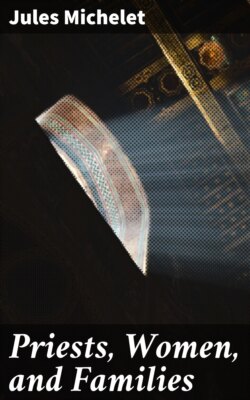Читать книгу Priests, Women, and Families - Jules Michelet - Страница 3
На сайте Литреса книга снята с продажи.
ОглавлениеPREFACES.
Editor's Preface
Author's Preface
Memoir
PART I.
ON DIRECTION IN THE SEVENTEENTH CENTURY.
CHAPTER I.
Religious Re-action in 1600—Influence of the Jesuits over Women and Children—Savoy; the Vaudois; Violence and Gentleness—St. François de Sales
CHAPTER II.
St. François de Sales and Madame de Chantal—Visitation—Quietism—Results of Religious Direction
CHAPTER III.
Loneliness of Woman—Easy Devotion—Worldly Theology of the Jesuits—Women and Children advantageously made use of—Thirty Years' War, 1618–1648—Gallant Devotion—Religious Novels—Casuists
CHAPTER IV.
Convents—Convents in Paris—Convents contrasted; the Director—Dispute about the Direction of the Nuns—The Jesuits Triumph through Calumny
CHAPTER V.
Re-action of Morality—Arnaud, 1643; Pascal, 1657—The Jesuits lose Ground—They gain over the King and the Pope—Discouragement of the Jesuits; their Corruption—They Protect the Quietists—Desmarets—Morin burnt, 1663—Immorality of Quietism
CHAPTER VI.
Continuation of Moral Re-action—Tartuffe, 1664—Real Tartuffes—Why Tartuffe is not a Quietist
CHAPTER VII.
Apparition of Molinos, 1675—His Success at Rome—French Quietists—Madame Guyon and her Director—"The Torrents"—Mystic Death—Do we return from it?
CHAPTER VIII.
Fenelon as Director—His Quietism—"Maxims of Saints," 1697—Fenelon and Madame de la Maisonfort
CHAPTER IX.
Bossuet as Director—Bossuet and Sister Cornuau—Bossuet's Imprudence—He is a Quietist in Practice—Devout Direction inclines to Quietism—Moral Paralysis
CHAPTER X.
Molinos' "Guide"—Part Played in it by the Director; Hypocritical Austerity—Immoral Doctrine; Approved by Rome, 1675—Molinos Condemned at Rome, 1687—His Morals—His Morals Conformable to his Doctrine—Spanish Molinosists—Mother Agueda
CHAPTER XI.
No more Systems: an Emblem—The Heart—Sex—The Immaculate—The Sacred Heart—Mario Alacoque—The Seventeenth Century is the Age of Equivocation—Chimerical Politics of the Jesuits—Father Colombière—England—Papist Conspiracy—First Altar of the Sacred Heart—The Ruin of the Galileans, Quietists, and Port-Royal—Theology annihilated in the Eighteenth Century—Materiality of the Sacred Heart—Jesuitical Art
PART II.
ON DIRECTION IN GENERAL, AND ESPECIALLY IN THE NINETEENTH CENTURY.
CHAPTER I.
Resemblances and Differences between the seventeenth and nineteenth Centuries—Christian Art—It is we who have restored the Church—What the Church adds to the Power of the Priest—The Confessional
CHAPTER II.
Confession—Present Education of the Young Confessor—The Priest in the Middle Ages—1st, believed—2ndly, was mortified—3rdly, knew—4thly, interrogated less—The Dangers of the Young Confessor—How he Strengthens his Tottering Position
CHAPTER III.
Confession—The Confessor and the Husband—How they Detach the Wife—The Director—Directors in Concert—Ecclesiastical Policy
CHAPTER IV.
Habit—Power of Habit—Its Insensible Beginning; its Progress—Second Nature; often fatal—A Man taking Advantage of his Power—Can we get clear of it?
CHAPTER V.
On Convents—Omnipotence of the Director—Condition of the Nuns, Forlorn and Wretched—Convents made Bridewells and Bedlams—Captation—Barbarous Discipline; Struggle between the Superior Nun and the Director; Change of Directors—The Magistrate
CHAPTER VI.
Absorption of the Will—Government of Acts, Thoughts, and Wills—Assimilation of the Soul—Transhumanation—To become the God of another—Pride and Desire
CHAPTER VII.
Desire. Terrors of the other World—The Physician and his Patient—Alternatives; Postponements—Effects of Fear in Love—To be All-powerful and Abstain—Struggles between the Spirit and the Flesh—Moral Death more Potent than Physical Life—It will not revive
PART III.
CHAPTER I.
Schism in Families—The Daughter; by whom Educated—Importance of Education—The Advantage of the First Instructor—Influence of Priests upon Marriage—Which they Retain after that Ceremony
CHAPTER II.
Woman—The Husband does not Associate with the Wife—He seldom knows how to Initiate her into his Thoughts—What Mutual Initiation would be—The Wife Consoles Herself with her Son—He is taken from her; her Loneliness and Ennui—A pious young Man—The Spiritual and the Worldly Man—Who is now the Mortified Man
CHAPTER III.
The Mother—Alone for a Long Time, she can bring up her Child—Intellectual Nourishment—Gestation, Incubation, Education—The Child Guarantees the Mother, and she the Child—She protects his Originality, which Public Education must Limit—The Father even Limits it, the Mother Defends it—Her Weakness; she wishes her Son to be a Hero—Her Heroic Disinterestedness
CHAPTER IV.
Love—Love wishes to raise and not absorb—False Theory of our Adversaries; Dangerous Practice—Love wishes to form an Equal who may love freely—Love in the World, in the Civil World—And in Families, not understood by the Middle Ages—Family Religion
ONE WORD TO THE PRIESTS:—We do not Attack Priests, but their Unhappy and Dangerous Position—Not Rome but France is the Pope—Our Sympathy for Priests, Victims of the Laws—Priests and Soldiers—Priest means Old Man
